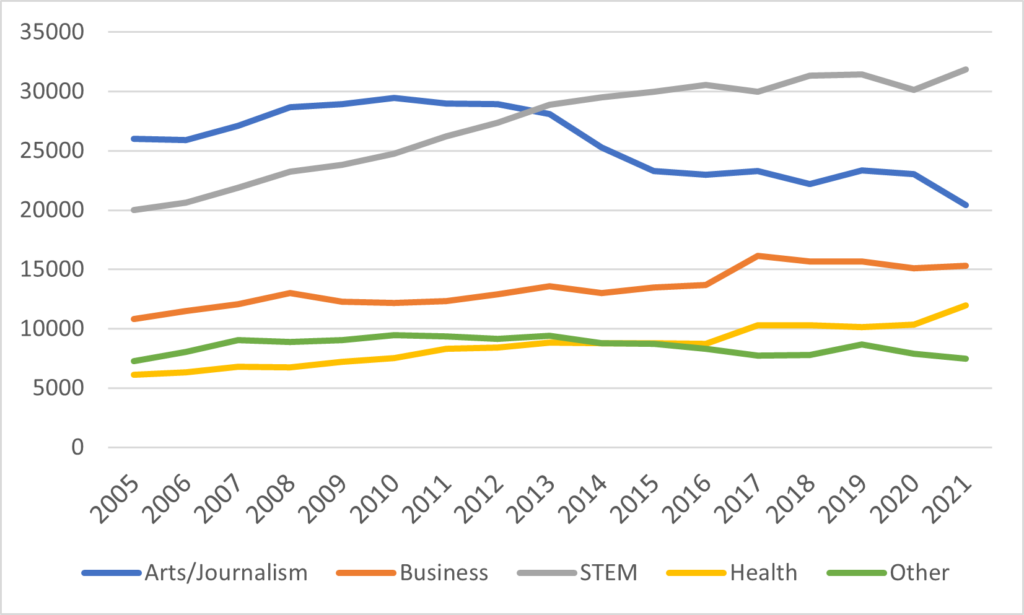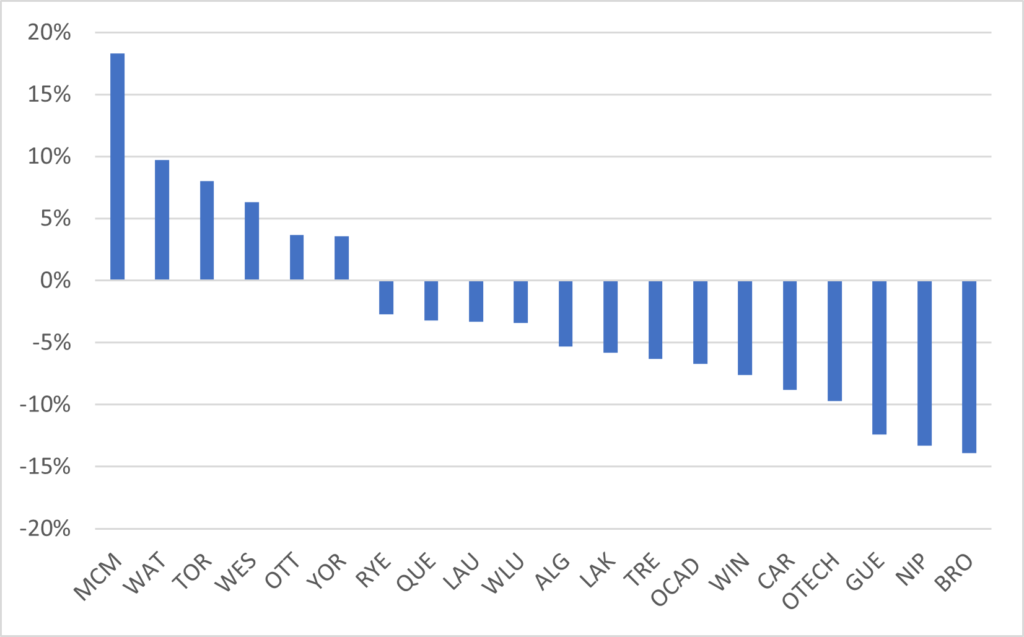Canada, as I think everyone is, on the whole, in the main, crap at educational data. When it comes to getting up-to-the-minute data on things like enrolments and applications, we’re mostly hopeless, because everyone does their own thing and nobody bothers to make their data public or comparable until Statscan comes along 28 or months or so after the fact. There are only two major exceptions to this: the Atlantic Association of Universities, which puts out a super-speedy enrolment check every October, and the Ontario Universities Application Centre (OUAC), which provides what amounts to real-time data on applications from secondary school graduates every April. The latter reported yesterday, and wowza there was some fascinating stuff in there.
Let’s start with the overall first choice applications. OUAC reports on 20-odd fields of study, which I combine into four major fields (Arts/Journalism, Business, STEM and Health) basically because it’s the only way to cover over a methodology change a few years ago, which otherwise made long-term comparisons impossible. What we saw this year were some of the biggest one-year shifts in program demands on record. First choice applications for Humanities were down 11%, Communications and journalism down 13%; together, those two falls brough the combined Arts/Journalism proportion of total applications to an all-time low of 23%, down from 37% just fifteen years earlier. Meanwhile, STEM and Health continue to rise. Biomedical Science applications were up by 10% this year, while Nursing rose by – hang on your hats – 80%. Call it a COVID effect, I guess, but those are some pretty crazy and almost unprecedented swings.
Figure 1: First-Choice Applications by Broad Field of Study, Direct-from Secondary Applicants to Ontario Universities, 2005-2021

But the chaos in fields of study is nothing compared to the big swings we’re seeing in the institutions to which they are applying. Broadly speaking, what we are seeing is an unprecedented “flight to big schools”.
Figure 2: First-Choice Applications by Broad Field of Study, Direct-from Secondary Applicants to Ontario Universities, 2020-2021

Jumps in applications of 10-15% are not completely unheard of at Ontario institutions, but when those things occur it tends to be to smaller schools working from lower bases. McMaster seeing a rise of 18%? Waterloo 10%? Toronto 8%? These kinds of numbers haven’t been seen since the double cohort. And meanwhile most institutions are seeing drops in applications, just as they need extra students to meet the bills of the past 12 months. Of course, application counts don’t translate directly into enrolments, but put it this way: there is going to be a lot of juggling of entrance averages this spring.
And then there’s the final, big piece of news, which concerns the new Université de l’Ontario français. After all the fanfare, after all the claims of pent-up demand for French-language post-secondary education in southern and central Ontario, it received exactly two first-choice applications from secondary school students. As in: one, two. Add in the three second-choice applications, six third choices and a bunch of even lower choices, they got up to a grand total of nineteen. Add in some applications of older students and students outside Ontario and apparently they are all the way up to forty.
So, I have noted before that UOFs projected application numbers were always extremely optimistic and arguably based on some bad social science. And, let’s face it, having to do your opening recruitment year in a pandemic can’t have been fun. But come on: something’s gone pretty badly wrong here. I don’t know if it was overconfidence on the part of a marketing team which genuinely believed its own press about the high demand for French-language education in Toronto, or if the university’s approach to designing an interdisciplinary program (which is genuinely cool, and with which I have a lot of sympathy) simply came off as a bit too high-concept for potential undergraduate students.
UOF is not in any immediate peril. The feds are on the hook for another three years of operating funding thanks to what now looks like a terrible deal with Ontario it signed twelve months ago. People will probably give the university a mulligan on recruiting for year one because of the pandemic. But it might not get a third chance at this. The stakes for next year’s intake are now very, very high.

 Tweet this post
Tweet this post

The shift to large institutions is interesting. Thoughts as to why? In particular, do the large institutions offer more in the way of online learning? Or are they places students can more like attend while still living at home?
Are we witnessing university monopoly?
When a student can stay at home to study, she or he can afford attending more expensive universities or ones that are located in more expensive cities, no?
If the applications for 2022 go back to normal then I think this will be seen as a blip for those who are expecting to need to do online education for a year. Those institutions who have a reputation for having good online education will likely attract more students this year, but I don’t know if it will be maintained after the pandemic.
It’s more likely because the large universities offer the more in demand programs like engineering and nursing. Not all of the smaller schools do.